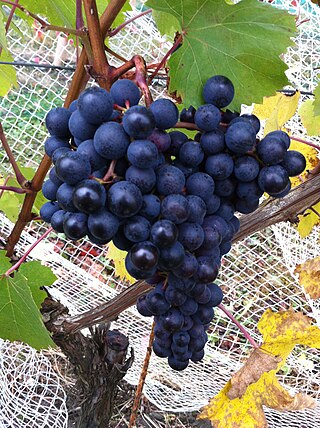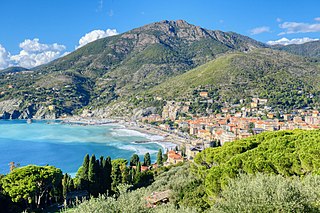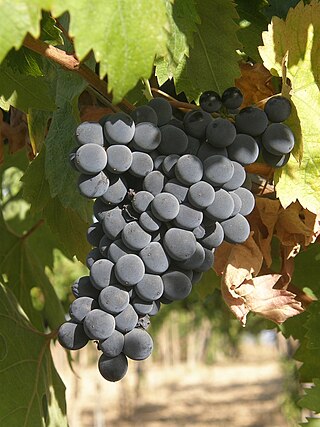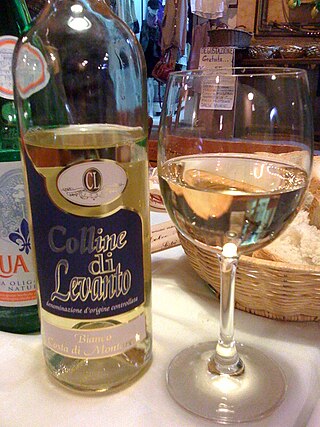
Dolcetto is a black Italian wine grape variety widely grown in the Piedmont region of northwest Italy. The Italian word dolcetto means "little sweet one", but it is not certain that the name originally carried any reference to the grape’s sugar levels: it is possible that it derives from the name of the hills where the vine is cultivated. In any case the wines produced are nearly always dry. They can be tannic and fruity with moderate, or decidedly low, levels of acidity and are typically meant to be consumed within a few years after release.

Sangiovese is a red Italian wine grape variety that derives its name from the Latin sanguis Jovis, "the blood of Jupiter".

The Cinque Terre is a coastal area within Liguria, in the northwest of Italy. It lies in the west of La Spezia Province, and comprises five villages: Monterosso al Mare, Vernazza, Corniglia, Manarola, and Riomaggiore. The coastline, the five villages, and the surrounding hillsides are all part of the Cinque Terre National Park, a UNESCO World Heritage Site. Vernazza is one of I Borghi più belli d'Italia.

Italian wine is produced in every region of Italy. Italy is the world's largest wine producer, as well as the country with the widest variety of indigenous grapevine in the world, with an area of 702,000 hectares under vineyard cultivation, and contributing a 2013–2017 annual average of 48.3 million hl of wine. In 2018 Italy accounted for 19 per cent of global production, ahead of France and Spain. Italian wine is both exported around the world and popular domestically among Italians, who consume an average of 42 litres per capita, ranking fifth in world wine consumption.

Vermentino is a light-skinned wine grape variety, primarily found in Italian wine. It is widely planted in both Sardinia and Liguria, to some extent in Corsica, in Piedmont under the name Favorita, and in increasing amounts in Languedoc-Roussillon. The leaves are dark green and pentagonal. The grapes are amber-yellow and hang in pyramidal bunches. The vines are often grown on slopes facing the sea where they can benefit from the additional reflected light. The Vitis International Variety Catalogue now gives Italy as its origin.

Montepulciano is a red Italian wine grape variety that is most noted for being the primary grape behind the DOCG wines Colline Teramane Montepulciano d'Abruzzo and Offida Rosso; and the DOC wines Montepulciano d'Abruzzo, Rosso Conero, and Rosso Piceno Superiore.

Piedmont wine is the range of Italian wines made in the region of Piedmont, in the northwestern corner of Italy. The best-known wines from the region include Barolo and Barbaresco. They are made from the Nebbiolo grape. These wines are ideal for storage and a well-aged Barolo for instance may leave a feeling of drinking velvet because the tannins are polished and integrated more and more into the wine. As the wine matures the colour becomes more brownish and rust-red.

Lombardy wine is the Italian wine produced in the Lombardy region of north central Italy. The region is known particularly for its sparkling wines made in the Franciacorta and Oltrepò Pavese areas. Lombardy also produces still red, white and rosé wines made from a variety of local and international grapes, including Nebbiolo wines in the Valtellina region and Trebbiano di Lugana white wines produced with the Chiaretto style rosé along the shores of Lake Garda. The wine region currently has 22 denominazione di origine controllata (DOC), 5 denominazione di origine controllata e garantita (DOCG) and at least 13 indicazione geografica tipica (IGT) designations. The main cities of the region are Milan, Bergamo and Brescia. The region annually produces around 1.3 million hectolitres of wine, more than the regions of Friuli-Venezia Giulia, Marche, Trentino-Alto Adige/Südtirol and Umbria.

Tuscan wine is Italian wine from the Tuscany region. Located in central Italy along the Tyrrhenian coast, Tuscany is home to some of the world's most notable wine regions. Chianti, Brunello di Montalcino and Vino Nobile di Montepulciano are primarily made with Sangiovese grape whereas the Vernaccia grape is the basis of the white Vernaccia di San Gimignano. Tuscany is also known for the dessert wine Vin Santo, made from a variety of the region's grapes. Tuscany has forty-one Denominazioni di origine controllata (DOC) and eleven Denominazioni di Origine Controllata e Garantita (DOCG). In the 1970s a new class of wines known in the trade as "Super Tuscans" emerged. These wines were made outside DOC/DOCG regulations but were considered of high quality and commanded high prices. Many of these wines became cult wines. In the reformation of the Italian classification system many of the original Super Tuscans now qualify as DOC or DOCG wines but some producers still prefer the declassified rankings or to use the Indicazione Geografica Tipica (IGT) classification of Toscana. Tuscany has six sub-categories of IGT wines today.
Montecarlo is a denominazione di origine controllata (DOC) in northern Tuscany, Italy. The vineyards surround the small town of Montecarlo which is located close to Lucca and Pisa. Montecarlo wines are unusual for the region in that they are commonly made from the Sémillon, Sauvignon blanc and Pinot bianco grape varietals. This is unusual as most Tuscan white wines are made from Trebbiano and Malvasia grapes. Wines from the region are often called the best Tuscan whites.
Cinque Terre is a small DOC white wine region in Liguria, North Italy. The DOC was granted in 1973 and production is limited to the coastal areas of the Cinque Terre in the Province of La Spezia, and specifically to the territories of the communes of Riomaggiore, Vernazza and Monterosso al Mare, together with two adjacent areas within the commune of La Spezia: Tramonti di Biassa and Tramonti di Campiglia.

Albarola is a white Italian wine grape variety grown in the northwest Italy. It is most commonly found in the Liguria region where producers in the Cinqueterre Denominazione di origine controllata (DOC) use it as a blending component. Wine expert Jancis Robinson describes the wine made from Albarola as fairly "neutral" in profile. Outside of Liguria, the grape was historically grown in Sicily but for most of the 20th century has been declining in plantings along with other ancient Sicilian varieties like Albanello, Damaschino, Minella bianca and Montonico bianco.

Colli di Luni is an Italian Denominazione di origine controllata (DOC) located in both Liguria and Tuscany in northwest Italy. The DOC produces both reds and white wines made primarily from Sangiovese and Vermentino with a varietal Vermentino also being produced in the DOC.

Colline di Levanto is an Italian Denominazione di origine controllata (DOC) located in Liguria that produces both red and white wines primarily from Sangiovese and Vermentino, respectively. Located next to the notable white wine only DOC of Cinque Terre, the Colline di Levanto has very similar vineyard soils and mesoclimate to its neighboring wine region.
Bracciola nera is a red Italian wine grape variety that is primarily found in the Liguria and Toscana wine regions of western Italy. The only Denominazione di origine controllata (DOC) that Bracciola nera plays a significant role is in the Colli di Luni DOC of Ligura where the grape is permitted to be blended with Sangiovese, Canaiolo, Pollera nera, Ciliegiolo, Vermentino nero and other varieties. A late-ripening variety, Bracciola nera usually contributes acidity to blends.
Colombana nera is a red Italian wine grape variety that is grown in Emilia-Romagna and Tuscany. Despite similarities in name, the grape did not get its name from nor is it grown in the San Colombano al Lambro region of Lombardy nor is it permitted in the Denominazione di origine controllata (DOC) wine of the same name. Rather, ampelographers believe that Colombana nera is named after the Abbey of San Colombano located in the commune of Bobbio in the Piacenza province of Emilia-Romagna where the grape has had a long history of cultivation.

Vermentino nero is a red Italian wine grape variety that is predominantly grown in province of Massa-Carrara in Tuscany. After World War II, the vine was almost lost to extinction until Podere Scurtarola, a producer from Massa, began replanting old vineyards with the grape. By 2000, there were 199 hectares of Vermentino nero growing in Italy with the grape authorized for production in the Denominazione di origine controllata (DOC) wines of Candia dei Colli Apuani and Colline Lucchesi.

Ligurian cuisine consists of dishes from the culinary tradition of Liguria, a region of northwestern Italy, which makes use of ingredients linked both to local production, and to imports from areas with which, over the centuries, the Ligurians have had frequent trade.














